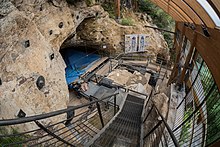Uluzzia
As Uluzzien is an archaeological culture called that by 2011 the Middle Palaeolithic , since the Upper Paleolithic is assigned, so not the Neanderthals , but the anatomically modern humans . The latter, however, only applies on the assumption that the earlier residents were displaced by the later ones. Robert G. Bednarik, on the other hand, argues that a culturally determined, more graceful body shape could have come about . In 2015, the assignment to the Upper Paleolithic, which suggested it to the Middle Paleolithic, was also questioned.
Altogether more than twenty uluzzia sites are known in Italy , another possible site is on the Peloponnese . The Uluzzien was dated between 45,000 and 37,000 BP . The name of the culture goes back to Baia di Uluzzo , a small bay in southern Apulia , where finds were made in the Grotta del Cavallo in the early 1960s .
The Uluzzien was often referred to as a "transition industry". Accordingly, it was between the Moustérien , in which Neanderthals still existed, and the Aurignacien , in which the anatomically modern man appeared in Europe. Arturo Palma di Cesnola discovered two teeth in the ulcer layer of the Grotta del Cavallo in 1964. For a long time they were assigned to Neanderthals, but Stefano Benazzi from the University of Vienna was able to prove in 2011 that they are teeth from an anatomically modern human being.


Until 2007, uluzzia was only found in the south of the peninsula, but this year uluzzo signs were also found in the Grotta della Fabbrica in the Tuscan Maremma . The most important sites in Apulia are the Grotta del Cavallo and the Grotta Bernardini and the Grotta Riparo di Uluzzo ; in Campania these are the Cala and Castelcivita caves - the latter is between 32,500 and 33,500 years old. The similarity with finds in the Klisoura cave in the Peloponnese is now disputed. In the Grotta di Fumane , 18 km northwest of Verona , there were paintings that belong to the Uluzzia. A total of four teeth were also found there during the excavations between 1989 and 2011, three of which were assigned to the Mousteria (Fumane 1, 4, 5) and one to the Uluzzia (Fumane 6). Fumane 6 could not be assigned with certainty to anatomically modern humans.
In addition to the few anatomical features and the changes in the stone processing due to a new concept, there were also changes in the handling of the captured animals.
The chronology of the Uluzzien technology, as it is presented in the Grotta Fumane, shows a considerable dynamic of change with regard to settlement dynamics as well as stone and bone processing, because its oldest artefacts are closer to the Moustérien, the younger ones to the Aurignacien. The cutting industry is based in the early phase on the Levallois technique, which is increasingly being displaced by cutting procedures that resulted in cuts and blades, but also back knives .
literature
- Katerina Douka, Thomas FG Higham , Rachel Wood, Paolo Boscato, Paolo Gambassini, Panagiotis Karkanas, Marco Peresani, Annamaria Ronchitelli : On the chronology of the Uluzzian , in: Journal of Human Evolution 68 (2014) 1–13.
- Julien Riel-Salvatore: What is a transitional industry? The Uluzzian of southern Italy as a case study , in: Marta Camps (Ed.): Sourcebook of Paleolithic Transitions. Methods, Theories, and Interpretations , Springer 2009, pp. 377-396.
- Aldo D'Alessio, Emilia Bramanti , Marcello Piperno , Gino Fornaciari: An 8500-year-old bladder stone from Uluzzo cave (Trapani): Fourier Transform-Infrared spectroscopy analysis , in: Archaeometry 47,1 (2005) 127-136. ( online )
Web links
- Jean-Luc Voisin: Mais qui sont les responsables des industries de transition, Néandertaliens ou Hommes modern? L'Uluzzien, attribué à tort à Néandertal, est en fait une production Homo sapiens, il ya 45,000 ans , Hominidés, 2011.
Remarks
- ^ Robert G. Bednarik: The Middle-Upper Paleolothic Transition revisited , in: Marta Camps, Parth Chauhan (Ed.): Sourcebook of Paleolithic Transitions. Methods, Theories, and Interpretations , Springer, 2009, pp. 272–282, here: p. 279.
- ↑ João Zilhão, William E. Banks, Francesco d'Errico, Patrizia Gioia: Analysis of Site Formation and Assemblage Integrity Does Not Support Attribution of the Uluzzian to Modern Humans at Grotta del Cavallo , in: PLoS ONE 10 (2015) ( online ) .
- ↑ Julien Riel-Salvatore: What is a 'Transitional' Industry? The Uluzzian of Southern Italy as a Case Study , in: Marta Camps, Parth R. Chauhan (Ed.): Sourcebook of Paleolithic Transitions. Methods, Theories, and Interpretations , Springer, 2009, pp. 377-396, here: p. 385.
- ^ Alberto Broglio, Giampaolo Dalmeri: Pitture paleolitiche nelle Prealpi venete. Grotta di Fumano e Riparo dalmieri , Verona 2005.
- ↑ Stefano Benazzi, Shara E. Bailey, Marco Peresani, Marcello A. Mannino, Matteo Romandini, Michael P. Richards, Jean-Jacques Hublin: Middle Paleolithic and Uluzzian human remains from Fumane Cave, Italy , in: Journal of Human Evolution 70 ( 2014) 61–68.
- ↑ Paolo Boscato, Jacopo Crezzini: Middle – Upper Palaeolithic transition in Southern Italy: Uluzzian macromammals from Grotta del Cavallo (Apulia) , in: Quaternary International , online advance publication of March 31, 2011, doi: 10.1016 / j.quaint.2011.03. 028
- ↑ Marco Peresani, Emanuela Cristiani, Matteo Romandini: The Uluzzian technology of Grotta di Fumane and its implication for reconstructing cultural dynamics in the Middle-Upper Palaeolithic transition of Western Eurasia , in: Journal of Human Evolution 91 (2016) 36-56.